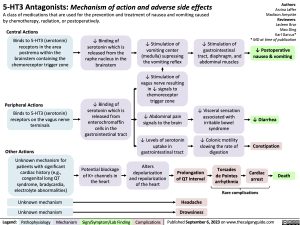5-HT3 Antagonists: Mechanism of action and adverse side effects A class of medications that are used for the prevention and treatment of nausea and vomiting caused by chemotherapy, radiation, or postoperatively.
Authors: Arzina Jaffer Madison Amyotte Reviewers: Jasleen Brar Mao Ding Karl Darcus* * MD at time of publication
↓ Postoperative nausea & vomiting
Central Actions
Binds to 5-HT3 (serotonin) receptors in the area postrema within the brainstem containing the chemoreceptor trigger zone
↓ Binding of serotonin which is released from the raphe nucleus in the brainstem
↓ Stimulation of vomiting center
(medulla) supressing the vomiting reflex
↓ Stimulation of vagus nerve resulting in ↓ signals to chemoreceptor trigger zone
↓ Abdominal pain signals to the brain
↓ Levels of serotonin uptake in gastrointestinal tract
↓ Stimulation of gastrointestinal
tract, diaphragm, and abdominal muscles
Peripheral Actions
Binds to 5-HT3 (serotonin) receptors on the vagus nerve terminals
Other Actions
Unknown mechanism for patients with significant cardiac history (e.g., congenital long QT syndrome, bradycardia, electrolyte abnormalities)
Unknown mechanism Unknown mechanism
↓ Binding of serotonin which is released from enterochromaffin cells in the gastrointestinal tract
Potential blockage of K+ channels in the heart
↓ Visceral sensation associated with irritable bowel syndrome
↓ Colonic motility slowing the rate of digestion
↓ Diarrhea
Constipation
Alters depolarization
and repolarization of the heart
Prolongation of QT interval
Headache Drowsiness
Torsades de Pointes arrhythmia
Cardiac arrest
Death
Rare complications
Legend:
Pathophysiology
Mechanism
Sign/Symptom/Lab Finding
Complications
Published September 6, 2023 on www.thecalgaryguide.com
Foundations
Systems
Other Languages
Pharmacology Drug Action 5-HT3 Antagonists: Mechanism of action and adverse side effects 5HT3 Antagonists

